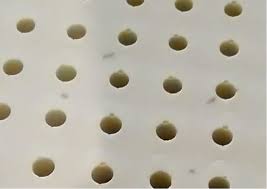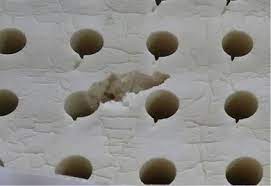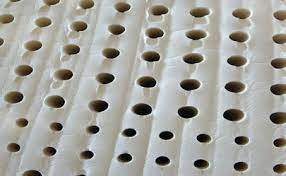What Is a Natural Latex Mattress? Everything You Need to Know [2025]
- Brendan Phuah
- Jul 10, 2021
- 6 min read
Updated: Jul 12

What is a Natural Latex mattress?
Latex mattresses are a product of nature. It is made from one or more blocks of latex core and does not contain any other materials like spring coils, fibre or memory foam. When other materials are combined, it becomes, at best, a hybrid mattress. A hybrid mattress would feel completely different from an all-natural latex mattress, and its lifespan would be a lot shorter, like spring or memory foam mattresses.
Therefore, contrary to some descriptions from the internet, which mentions that a latex mattress combines latex foam with either springs or reflex foam to create a supportive and durable sleep surface, a mattress cannot be called a natural latex mattress once other materials are combined to make it.

How is Latex core made?
The process of making a latex core is like baking bread. The first is to prepare the main ingredient by frothing latex sap harvested directly from the Para rubber tree (Hevea brasiliensis). Then they are filled into a mould and added with a small portion (up to 4%) of hardening agents. Then the mould is placed in a giant oven and baked.
This process of making solidifying latex sap into solid cores is called vulcanisation. This process was invented in the 1800s, but it was only in the early 1900s that the technicians from Dunlop Germany established a standard method for foaming Latex. This method became the standard for making latex cores, known to us today as the Dunlop process. "Dunlop latex" is denser than Latex made through the Talalay process. The final product is about 95% natural, imperfect and every piece is unique.
Are all Latex mattresses the same?
There are three types of Latex mattresses produced in the market - Fully natural Latex, Synthetic Latex and Blended Latex.

1.Natural Latex
A Latex mattress made of only the milky sap of the rubber tree is referred to as a 100% all-natural latex mattress. However, the term 100% natural is also misleading as no latex foam producers can vulcanise natural latex sap into foam without adding some ingredients such as soaps and foaming agents. However, these ingredients are not harmful, but they are there, and their percentage needs to be considered.
Latex foams in all SYMFONI latex mattresses are certified by the Rubber Authority of Thailand to have a minimum of 96% natural latex content and no more than 4% additives. This percentage is considered one of the highest percentage natural latex in the mattress industry. We make all of our natural latex mattresses in Singapore.
2. Synthetic Latex
Also known as styrene-butadiene rubber (SBR), this is an artificial material. Synthetic Latex is made of petroleum-based components and can also be blended with polyurethane. The reasons for making synthetic foams are due to cost; synthetic latex foam is easy and quick to produce and at a fraction of the cost of natural latex foam. It can also help to stabilise the manufacturing process. However, taking such "shortcuts" will directly impact the health of users as they are carcinogenic.
3. Blended Latex
Blended cores are made from natural and synthetic Latex, generally with 30% natural Latex or less, and synthetic. Blended cores the most commonly found in the market today. Unfortunately, it is hard to spot them as they are marketed as 100% natural. They can even be certified as "100% natural" even though they are not all-natural.
Blended cores yield properties of both types but are not as durable and resilient as all-natural Latex cores.
How to tell if a Latex is natural or not?
The Latex that looks close to perfect is most likely the result of adding synthetic Latex or chemicals to the compound. This is the nature of synthetic materials; they look perfect, but the chemicals embedded in them are bad for one's health. So, manufacturers would add a pleasant scent (normally vanilla) to the synthetic Latex to mask the odour coming from these chemicals.
Vulcanising natural Latex is a lot harder to control, and as a result, the natural latex foam will produce some inconsistencies. However, these imperfections do not impact the performance or durability of the foam and will therefore fall within our quality control parameters.
Most common variations in natural latex foam:
discolouration/yellowness as a result of the baking process
cracks and tears from detaching the Latex from the mould with pins
'voids' caused by air bubbles that surface during baking.
a round mark on the Latex core, generally in the middle
small pieces of black or brown residual Latex from the mould
rough/non-smooth surface if the foam has been sliced
So a sure way to spot synthetic latex foam is to smell them. If it smells nice or there is no rubber smell, it is not natural Latex.
What are the main benefits of a latex mattress?
Non-Toxic: Latex is harvested from the rubber tree and therefore free from chemicals and VOCs.
Responsive support: It provides firm support while also plush in feel. So it adapts to the sleepers body weight and shapes while keeping their spine in perfect posture.
Very breathable: with its open cell structure, the mattress ventilates very well and keeps the sleeping temperature cool and well managed.
Pressure relieving: Its inherent plushness relieves much pressure and promotes good blood circulation too. Eg. A Latex topper can improve the quality of a hard mattress.
Consistent sleeping surface: As it is a single block, every point on the mattress surface is supported, all to the edges.
Hygienic: It is naturally anti-dust mite, anti‐microbial and anti‐bacterial, therefore, suitable for people with allergies.
Very durable. Latex mattresses are known to last longer than mattresses made of other materials such as spring coil and PU foam.
What are the characteristics of a Latex mattress?
Latex mattresses have a unique characteristic: they are firmer than other mattresses but are not harder. On the other hand, they are plushier but not soft. In essence, it is the same character as natural rubber.
Buying a latex bed can be confusing at first because they do not come with a 7/10 or 8/10 rating to describe them. To provide a better understanding, let us look at two areas:
Construction of a latex mattress
Dense vs hard
Mattress construction
Latex mattresses are made with one or more layers of latex cores that match the mattress size; no spring coils or layered with PU foam. So mattresses made with mixed layers of latex and memory foam cannot be categorised as latex mattresses. Furthermore, this combination is a poor match because the memory foam will break down much earlier than the latex layers, shortening the mattress's lifespan altogether.
The ideal design and construction of a latex mattress should not restrict the natural benefits that come with the latex core.
The mattress should not contain thick covers: this will create a rigid sleeping surface and increases the chance of unevenness developing due to the wear and tear of these non-latex materials.
The outer cover should not be sewn tightly as this will restrict the natural elasticity of the latex core.
When design in multiple layers, the bottom layers must have the highest volume or thickness to maintain an overall stable core.
Density vs ILD
Density is the amount of Latex sap used to make a latex core for a latex mattress, measured in kg/m3. The higher the density, the more compact it feels. Likewise, lower density means plushier. A spring or foam mattress with the same ILD as a Latex mattress will feel very different. Therefore, the same standard cannot be used to compare Latex and non-latex mattresses.
While spring or foam mattresses use the terminologies like a firm, orthopaedic firm, medium-firm, plush firm or soft, and some even use numbers like 7/10 or 8/10, it would be easier to describe a Latex mattress medium or firm density that corresponds to its actual foam density. Regardless of medium or firm cores, a latex mattress is will always feel firm and keep the sleeper's sleeping posture aligned. Hence, a medium-density core would feel plushier than a firm core.
In conclusion, words cannot fully describe how a latex mattress would feel. Its characteristics are somewhat dynamic, and can we often get differing opinions from our clients testing the same mattress in our sleep studio @ BayShop.
So when buying the right mattress, even a baby mattress, one should always test the mattress in person. Therefore, the best way is to visit a showroom or sleep studio designed with a peaceful setting built like a bedroom to sleep-test an all-organic latex mattress meaningfully while getting one's questions answered by a knowledgeable mattress specialist.
Be Rest Assured




Comments